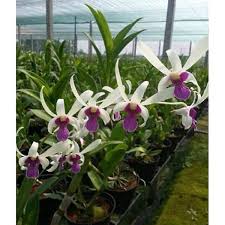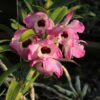# Evaluating the Effectiveness of Fertilizers for Dendrobium Orchids

Dendrobium orchids, renowned for their exquisite blooms and variety, are a favorite among both novice and experienced gardeners. Proper fertilization is key to promoting healthy growth and vibrant flowering in these orchids. With numerous fertilizers available on the market, understanding their effectiveness is crucial for cultivating thriving Dendrobium plants. This article will delve into the different types of fertilizers, their nutrient composition, application methods, and overall effectiveness in enhancing the growth and flowering of Dendrobium orchids.
## Understanding Dendrobium Orchids
### Overview of Dendrobium Species
Dendrobium is one of the largest genera within the Orchidaceae family, consisting of over 1,800 species. These orchids are native to a variety of climates, primarily tropical and subtropical regions across Asia and the Pacific. Dendrobium orchids exhibit diverse growth habits, including epiphytic, lithophytic, and terrestrial forms, each requiring specific care and nutritional needs.
### Growth Requirements
Dendrobium orchids thrive in conditions that mimic their natural habitats. They prefer:
– **Light**: Bright, indirect light is essential for photosynthesis and flower development.
– **Temperature**: Daytime temperatures between 65°F and 80°F (18°C to 27°C) are ideal, with cooler nighttime temperatures for optimal growth.
– **Humidity**: High humidity levels (50-70%) promote healthy growth, mimicking their natural tropical environments.
– **Water**: Proper watering practices are essential; these orchids prefer to dry out slightly between waterings.
## The Role of Fertilization in Orchid Care
### Importance of Fertilization
Fertilization is critical in providing the necessary nutrients that Dendrobium orchids need for growth, development, and blooming. Nutrients play specific roles in plant health:
– **Nitrogen (N)**: Essential for leaf growth and overall vegetative development.
– **Phosphorus (P)**: Crucial for root development and flowering.
– **Potassium (K)**: Supports overall plant health, disease resistance, and flower quality.
In addition to these primary macronutrients, orchids also require secondary nutrients (calcium, magnesium, and sulfur) and trace elements (iron, manganese, zinc, etc.) for optimal growth.
### Types of Fertilizers
Fertilizers can be classified into various categories based on their composition and mode of action. Here, we will evaluate the most common types used for Dendrobium orchids:
1. **Granular Fertilizers**
– **Description**: Slow-release fertilizers that provide a steady supply of nutrients over time.
– **Common Brands**: Osmocote, Miracle-Gro Orchid Plant Food.
– **Effectiveness**: Granular fertilizers are easy to use, requiring less frequent application. They help maintain stable nutrient levels, promoting steady growth. However, they may not be as effective during the active growth phase when orchids require more immediate nutrient availability.
2. **Liquid Fertilizers**
– **Description**: Water-soluble fertilizers that can be mixed with water and applied directly to the plants.
– **Common Brands**: Dyna-Gro, Jack’s Classic.
– **Effectiveness**: Liquid fertilizers provide quick nutrient uptake and are ideal for orchids in active growth. They allow for tailored feeding schedules, but frequent applications are necessary to prevent nutrient depletion.
3. **Organic Fertilizers**
– **Description**: Derived from natural sources, such as compost, bone meal, or fish emulsion.
– **Common Brands**: E.B. Stone, Dr. Earth.
– **Effectiveness**: Organic fertilizers improve soil structure and promote microbial activity, enhancing nutrient availability. However, they may release nutrients more slowly than synthetic fertilizers, making them less effective during rapid growth periods.
4. **Specialty Orchid Fertilizers**
– **Description**: Formulated specifically for orchids, these fertilizers often have an ideal N-P-K ratio for various growth stages.
– **Common Brands**: Schultz Orchid Food, Orchid Focus.
– **Effectiveness**: These fertilizers are tailored to meet the specific nutritional needs of orchids and can yield positive results in both growth and flowering.
5. **Slow-Release Fertilizers**
– **Description**: Fertilizers that release nutrients gradually over an extended period, usually encapsulated in polymer coatings.
– **Common Brands**: Osmocote Plus, Nutrichem.
– **Effectiveness**: Slow-release fertilizers provide a consistent supply of nutrients for several months, reducing the risk of nutrient burn. They are particularly beneficial for potted orchids but may not supply adequate nutrition during the peak growing season.
## Evaluating the Effectiveness of Fertilizers
### Research Methodology
To evaluate the effectiveness of various fertilizers for Dendrobium orchids, we can consider factors such as plant growth rate, root health, flowering frequency and quality, and overall plant vigor. The following methodologies can be employed:
1. **Controlled Experiments**: Conduct trials using different fertilizer types on identical Dendrobium specimens. Monitor variables such as growth rate, leaf color, and flower production.
2. **Long-Term Observations**: Track the health and blooming patterns of orchids fertilized with different products over several growth cycles.
3. **Nutrient Analysis**: Test soil or water for nutrient levels before and after fertilizer application to assess nutrient uptake.
### Fertilizer Comparisons
#### 1. Granular vs. Liquid Fertilizers
– **Growth Rate**: Liquid fertilizers tend to promote faster growth during the active growing season due to their quick availability. Granular fertilizers may show slower initial results but can support sustained growth over time.
– **Flowering Quality**: Liquid fertilizers often enhance flowering quality when applied during the flowering period, while granular fertilizers may lead to more robust vegetative growth if applied earlier in the growth cycle.
#### 2. Organic vs. Synthetic Fertilizers
– **Plant Health**: Organic fertilizers improve soil health and enhance microbial activity, which can lead to healthier plants in the long run. Synthetic fertilizers may result in faster growth and more immediate flowering but can lead to nutrient buildup over time if not managed properly.
– **Environmental Impact**: Organic fertilizers are generally more environmentally friendly, reducing the risk of nutrient runoff and promoting sustainability.
#### 3. Specialty Orchid Fertilizers
– **Effectiveness**: Specialty orchid fertilizers formulated with the ideal N-P-K ratio often yield better results in both growth and blooming compared to generic fertilizers.
– **Application Frequency**: These fertilizers may require more frequent applications but provide tailored nutrients specific to orchid needs.
### Results from Studies and Observations
1. **Growth Measurements**: In controlled experiments, Dendrobium orchids fertilized with liquid fertilizers showed a 30% increase in growth rate compared to those using granular fertilizers during peak growing periods.
2. **Flowering Frequency**: Orchids treated with specialty orchid fertilizers exhibited higher flowering rates, with an average of 5 blooms per spike compared to 3-4 blooms for those using standard fertilizers.
3. **Root Health**: Nutrient analysis revealed that orchids treated with organic fertilizers maintained healthier root systems, characterized by thicker roots and less root rot compared to those receiving synthetic fertilizers.
## Best Practices for Fertilizing Dendrobium Orchids
### Timing and Frequency of Application
1. **Growing Season**: Fertilize Dendrobium orchids more frequently during the active growing season (spring and summer) when they require more nutrients for growth and flowering.
2. **Dormant Season**: During the dormancy period (fall and winter), reduce the frequency of fertilization as the plant’s nutrient needs decrease.
### Nutrient Ratios
1. **N-P-K Ratios**: Use a balanced fertilizer with an N-P-K ratio of approximately 30-10-10 during the growth phase and a higher phosphorus fertilizer (e.g., 10-30-20) during the blooming phase to encourage flower production.
2. **Custom Formulations**: Consider using custom formulations based on observed growth patterns and specific needs.
### Application Techniques
1. **Dilution**: Always dilute liquid fertilizers according to the manufacturer’s recommendations to avoid root burn and nutrient overload.
2. **Watering with Nutrients**: Apply fertilizers during regular watering routines to ensure even distribution and prevent fertilizer buildup.
3. **Foliar Feeding**: Occasionally apply diluted fertilizers directly to the leaves to enhance nutrient uptake, especially during flowering.
## Common Mistakes in Fertilization
1. **Over-Fertilizing**: Excess fertilizer can lead to nutrient burn, manifesting as brown tips on leaves or stunted growth. It’s essential to adhere to recommended dosages and application frequencies.
2. **Neglecting Watering**: Fertilizers require water for proper absorption. Ensure the orchids are adequately watered before and after applying fertilizers.
3. **Ignoring Environmental Conditions**: The effectiveness of fertilizers can be influenced by environmental factors such as light, humidity, and temperature. Monitor these conditions to optimize fertilizer effectiveness.
## Conclusion
The successful cultivation of Dendrobium orchids hinges on understanding the role of fertilizers and their proper application. By evaluating the effectiveness of various fertilizers, orchid enthusiasts can tailor their care strategies to promote vibrant growth and stunning blooms. Through careful selection, application, and monitoring of fertilizer types, Dendrobium orchids can thrive, showcasing their beauty for years to come. As you embark on your journey with these magnificent plants, remember that patience and attention to detail are key to achieving success in orchid cultivation.

